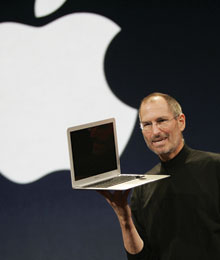Apple: A Fruitful Revolution
February 2, 2009 by City Life Staff
Filed under Success Story

If you were using an Apple computer in the early ’90s, you were part of a small cult-like group of people using a deteriorating product. With limited available software, declining sales and the absence of a true leader, Apple was undergoing gloomy technological Dark Ages that made it difficult to stay competitive. This is hard to believe today, where everybody who’s anybody has at least one of the company’s products.
Whether walking to school listening to your iPod or driving downtown with directions from your iPhone, you’re now on the other side of the fence. People everywhere are discovering why stores stock their shelves from top to bottom with Apple products, compared to a small cornered section 15 years ago. Apple can proudly say it’s won a hard battle to become No. 1, and fans are no longer part of a tiny sect.
The company’s humble beginning is a legendary tale in itself. Over 30 years ago, a revolution began that would shape the way we see our world, and it all started on Crist Drive in Los Altos, California. The address marks the birthplace of a business that would define how we communicate, learn, work and play. It was 1976 when Apple was founded, as Steve Jobs and Steve Wozniak gathered in the home garage of Jobs with basic textual-video chips and a wooden workbench. Together, the wiz-duo joined forces to make and market one of the globe’s first-ever personal computers. The Apple I found today in the Smithsonian was sold for $666.66. The motherboard-only device consisted of a CPU, RAM and a few microchips. If you wanted to use it, you would have to find your own case, keyboard and a monitor. Nonetheless, the Apple I was radically innovative for its time, and paved the way for much of what we now consider everyday electronic essentials.
As the company grew and expanded, it reached a defining moment about a decade later, foreshadowed by an ingenious marketing strategy. The masterpiece television commercial called 1984 was aired at the Super Bowl XVIII of that year, making way for the arrival of the Macintosh computer. With an outrageous production and broadcast budget of $1.5 million, the ad showcased the idea of empowerment and originality – something the Mac would offer. When the new product was finally unveiled a few weeks later, cries of amazement bellowed from a crowd of 3,000 people, who gave a five-minute standing ovation after seeing animated text and images move across a small screen.
Of course, no one knew that was just the beginning. Today, the sleek iMac is one of a multitude of products that have exploded into the global spotlight. People everywhere are giving into the craze and jumping on the bandwagon, switching from their Windows PCs to what CNET calls the “must-have desktop.” And there are tons of reasons why. If you ask Willy Powell, Apple’s strategic development manager, he’ll tell you it’s all about software. “It’s got an incredibly simple application that you can give to a five-year-old or a grandmother and yet if you peel back the covers you’ll find an unbelievable, industrial-strength operating system that’s reliable, stable, and easy-to-use,” he says.
And I’d have to agree with Powell. Ever since I switched from my Windows-based laptop to a Mac Book, I’ve never had a single letdown. When it comes to boot time, I don’t need to make myself a coffee while my computer starts up. The Mac OS X software is faster than lightning, and that applies to booting, shutting down and general usage. If I want to take a break, I’ll use the ever-reliable sleep mode, which felt more like a cross-your-fingers crapshoot after vain attempts with my Microsoft system. Most importantly, I’ve never had to buy anti-viral software, because my Mac Book hasn’t caught a single virus. Software aside, I’m compelled to recognize good-quality parts when I see them. After accidentally dropping my laptop a few times, my panic was quickly relieved at the sight of an undamaged, sturdy piece of equipment. It’s been an overall experience that also benefited me when I started working at City Life. The transition was effortless, since like most major companies around the world, our office is outfitted 100 per cent with Apple products.
The iPod is another revolutionary product that’s impacted people’s lifestyles. Regardless of what version you choose, the device literally puts thousands of songs in your pocket at the weight of a feather. Since it’s launch in 2001, the media player has replaced every means of portable music. If you think back to the cumbersome compact disc CD players or the big and bulky boom boxes, you can’t help but recognize that Apple’s handheld gadget is a pioneer for its time.
After speaking to Carmine De Santo, CEO of Loop Enterprise, I learned some spellbinding tidbits about the iPod Touch. The Apple certified technician – whose Apple-recognized company provides proactive IT solutions in-house or remotely – tells me how he uses the device’s software development kit (SDK). “It allows me to download all the applications I need for my productive business days,” he says. “If I need to do some voice recording while I drive, I talk to my Touch. If I need to find out where the closest Tim Hortons is, I have my Touch. The possibilities are endless.” The resourceful SDK, which was announced early last year at an Apple Town Hall meeting, allows anyone to join the Touch’s development team for a fee. Once you develop an application, it goes on sale in the App Store, where you’ll receive 70 per cent of the revenue generated per download.
Much like the first personal computer in the ’70s, the iPhone took the world by storm with its release. Since its introduction in 2007, a whopping 13 million people around the world now use the renowned device. Similar to the iPod Touch, with the added features of access to telecommunications, camera, microphone, Bluetooth technology and GPS receiver, the iPhone resembles what was once found only on TV. The touch screen and virtual keyboard reminds fans of Star Trek: The Next Generation’s tricorder, the handheld computer used to scan unfamiliar areas and diagnose diseases – and don’t be surprised if that comes true, too.
Apple’s research and development team is constantly toiling away at its Cupertino, California headquarters, although you’ll never get any insight into what’s coming out next, says De Santo. Speaking about the company’s annual January conference, which unveiled the latest news and products, he tells me how the conferences have a lid-tight execution. “There’s maybe five people in the world who know what’s being released, because Steve Jobs keeps it pretty quiet,” De Santo explains. “When it comes to new parts, announcements, innovation and new design, it’s all proprietary. It’s worse than the Secret Service.” However, the one secret that was revealed in January 2009 informed consumers that the conference was the company’s last, since Apple products are capable of marketing themselves.
Besides product performance, Apple’s sweeping grasp on the computing, entertainment and communication industries is also about looks. While judging a book by its cover might be superficial, you can’t turn a blind eye to the products’ aesthetics. With clean-cut exteriors that forgo littering arrays of blinking lights commonly found on other manufacturers’ products, Apple has its line of sight on visual appeal. The same is true when it comes to keys and controls. “Why does a stove or an oven need 10 buttons to set the temperature when a simple dial has always worked?” Powell asks. “Engineers and designers try to complicate things to make them better, but Apple’s approach is to simplify.” It’s yet another reason why the company is trumping the global market.
With so many innovations in such a short time, the future of Apple seems limitless. From a company that set out to create an electronic tool for people’s homes, it’s ultimately changed entire lifestyles. If Apple continues on its path of evolving technology, who knows how many more science fiction ideas will become reality. www.apple.com
















Comments
Feel free to leave a comment...
and oh, if you want a pic to show with your comment, go get a gravatar!